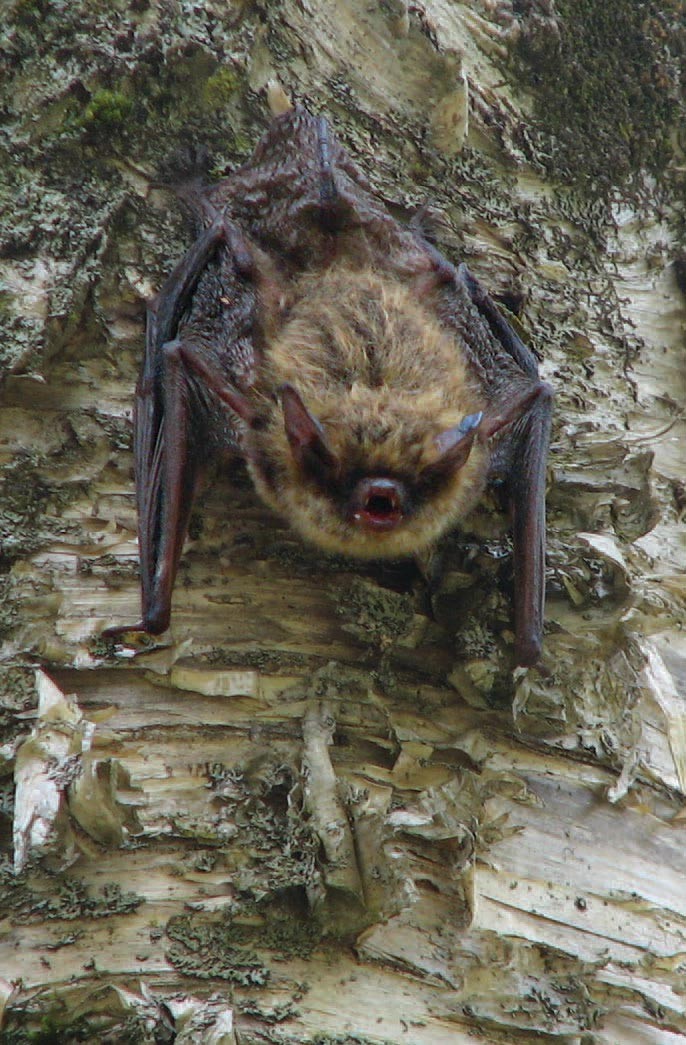I’ve seen some bats flying around the edge of my woods, and I’d really like to help them because I know that they’ve been hit pretty badly by white-nose syndrome. Where are they likely to roost in my forest? And are there specific ways for me to help boost their numbers?
Of the nine species of bats that live in New England and New York, two are federally listed as endangered and eight are listed as threatened or endangered in one or more states. Of these nine bat species, six overwinter in large numbers in hibernacula (usually caves and abandoned mines), while the other three migrate to southern climes. All nine species spend much of the summer in our forests, foraging, mating, and raising their young.
There are four main components to great bat habitat: roosting areas, foraging opportunities, hibernacula, and access to open water. For forest landowners and managers who would like to help bats, promoting and protecting roosting and foraging habitat is the best way to do so.
Roosting habitat is where bats sleep during the day and raise their young. In general, female bats roost with their pups, sometimes in large colonies, while male bats tend to roost singly. Active roosts can harbor hundreds of females with their flightless pups. Different bat species have different roosting preferences, but in general, bats roost under shaggy tree bark, in tree crevices and cavities, in snags, in the foliage of large living trees, and on sunny cliffs and talus slopes.
Our region’s two federally endangered species – the Indiana bat (Myotis sodalis) and the northern long-eared bat (Myotis septentrionalis) – have different roosting needs. The Indiana bat prefers to roost in dominant or co-dominant trees (trees in the overstory of the forest), under bark that is peeling in a roof-like fashion, and with good exposure to sunlight. While many different species of trees (especially old trees) can have bark like this, the most important and commonly utilized roost tree species for Indiana bat is shagbark hickory. Other common roost trees for this bat species include living and dead white pine, elm, and ash. By contrast, the northern long-eared bat prefers to roost in deep cavities in suppressed living trees (trees overtopped by others) and in snags under a relatively dense, high canopy.
We can manage for roosting habitat using some of the tools and techniques previously outlined in this column. Maintaining snags, cavity trees, and legacy trees in your woods will provide roosting opportunities for bat species that roost in cavities, under sloughing bark, and in the canopy of larger trees. Managing your forest using a crop tree release mindset – releasing crop trees, but retaining trees not competing with crop trees – will help protect some trees that have cavities, may develop cavities, or may become snags in your woods.
There are also some specific techniques for protecting bat-roosting habitat. Within the range of the Indiana bat, it is important to retain as much shagbark hickory, and other trees with sloughing bark, as possible. For all tree-roosting bat species, it is important to avoid cutting potential roost trees between April and October, when bats are active in the forest.
The other element of encouraging great bat habitat is managing forests for foraging habitat. All of New England’s bats are insectivores, eating as many as 1,000 insects per hour – consuming about half their body weight each night. In the woods, insect densities tend to be higher in canopy gaps, and several species of bats prefer foraging in lower-density stands. Thinning the forest, creating gaps and groups of different sizes, and in general promoting diverse, complex, and multigenerational forests will help provide great foraging habitat.
Although we may not see them often, bats are an important piece of the complex community that is a forested ecosystem. For example, a recent study from the University of Illinois found that tree defoliation by insects was greatly increased in a forest without bats, and researchers postulated that this could increase forest vulnerability – making trees more susceptible to climate change and other stressors. Incorporating bat habitat management into the way we manage our forests can help safeguard their health and their future.


